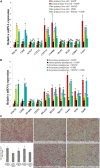Integrative Analyses of mRNA Expression Profile Reveal SOCS2 and CISH Play Important Roles in GHR Mutation-Induced Excessive Abdominal Fat Deposition in the Sex-Linked Dwarf Chicken
- PMID: 33519913
- PMCID: PMC7841439
- DOI: 10.3389/fgene.2020.610605
Integrative Analyses of mRNA Expression Profile Reveal SOCS2 and CISH Play Important Roles in GHR Mutation-Induced Excessive Abdominal Fat Deposition in the Sex-Linked Dwarf Chicken
Abstract
Sex-linked dwarf (SLD) chicken, which is caused by a recessive mutation of the growth hormone receptor (GHR), has been widely used in the Chinese broiler industry. However, it has been found that the SLD chicken has more abdominal fat deposition than normal chicken. Excessive fat deposition not only reduced the carcass quality of the broilers but also reduced the immunity of broilers to diseases. To find out the key genes and the precise regulatory pathways that were involved in the GHR mutation-induced excessive fat deposition, we used high-fat diet (HFD) and normal diet to feed the SLD chicken and normal chicken and analyzed the differentially expressed genes (DEGs) among the four groups. Results showed that the SLD chicken had more abdominal fat deposition and larger adipocytes size than normal chicken and HFD can promote abdominal fat deposition and induce adipocyte hypertrophy. RNA sequencing results of the livers and abdominal fats from the above chickens revealed that many DEGs between the SLD and normal chickens were enriched in fat metabolic pathways, such as peroxisome proliferator-activated receptor (PPAR) signaling, extracellular matrix (ECM)-receptor pathway, and fatty acid metabolism. Importantly, by constructing and analyzing the GHR-downstream regulatory network, we found that suppressor of cytokine signaling 2 (SOCS2) and cytokine-inducible SH2-containing protein (CISH) may involve in the GHR mutation-induced abdominal fat deposition in chicken. The ectopic expression of SOCS2 and CISH in liver-related cell line leghorn strain M chicken hepatoma (LMH) cell and immortalized chicken preadipocytes (ICP) revealed that these two genes can regulate fatty acid metabolism, adipocyte differentiation, and lipid droplet accumulation. Notably, overexpression of SOCS2 and CISH can rescue the hyperactive lipid metabolism and excessive lipid droplet accumulation of primary liver cell and preadipocytes that were isolated from the SLD chicken. This study found some genes and pathways involved in abdominal fat deposition of the SLD chicken and reveals that SOCS2 and CISH are two key genes involved in the GHR mutation-induced excessive fat deposition of the SLD chicken.
Keywords: CISH; SOCS2; abdominal fat deposition; differentially expressed gene; sex-linked dwarf chicken.
Copyright © 2021 Chen, Chen, Wu, Ren, Li, Lu, Cheng, Tan, Liu, Luo, Liang, Nie, Zhang and Luo.
Conflict of interest statement
The authors declare that the research was conducted in the absence of any commercial or financial relationships that could be construed as a potential conflict of interest.
Figures







Similar articles
-
Integrative Analyses of mRNA Expression Profile Reveal the Involvement of IGF2BP1 in Chicken Adipogenesis.Int J Mol Sci. 2019 Jun 14;20(12):2923. doi: 10.3390/ijms20122923. Int J Mol Sci. 2019. PMID: 31208008 Free PMC article.
-
[The cell cycle pathway regulates chicken abdominal fat deposition as revealed by transcriptome sequencing].Yi Chuan. 2019 Oct 20;41(10):962-973. doi: 10.16288/j.yczz.19-098. Yi Chuan. 2019. PMID: 31624058 Chinese.
-
Growth hormone receptor gene influences mitochondrial function and chicken lipid metabolism by AMPK-PGC1α-PPAR signaling pathway.BMC Genomics. 2022 Mar 19;23(1):219. doi: 10.1186/s12864-021-08268-9. BMC Genomics. 2022. PMID: 35305578 Free PMC article.
-
Molecular Regulation of Lipogenesis, Adipogenesis and Fat Deposition in Chicken.Genes (Basel). 2021 Mar 13;12(3):414. doi: 10.3390/genes12030414. Genes (Basel). 2021. PMID: 33805667 Free PMC article. Review.
-
Genomic Insights Into the Multiple Factors Controlling Abdominal Fat Deposition in a Chicken Model.Front Genet. 2018 Jul 19;9:262. doi: 10.3389/fgene.2018.00262. eCollection 2018. Front Genet. 2018. PMID: 30073018 Free PMC article. Review.
Cited by
-
Identification of mutations in porcine STAT5A that contributes to the transcription of CISH.Front Vet Sci. 2023 Jan 17;9:1090833. doi: 10.3389/fvets.2022.1090833. eCollection 2022. Front Vet Sci. 2023. PMID: 36733428 Free PMC article.
-
Regulation of Non-Coding RNA in the Growth and Development of Skeletal Muscle in Domestic Chickens.Genes (Basel). 2022 Jun 9;13(6):1033. doi: 10.3390/genes13061033. Genes (Basel). 2022. PMID: 35741795 Free PMC article. Review.
-
Lactobacillus paragasseri HM018 derived from breast milk ameliorates hyperlipidemia in high-cholesterol rats by modulating bile acid metabolism.Front Microbiol. 2025 Jun 4;16:1599931. doi: 10.3389/fmicb.2025.1599931. eCollection 2025. Front Microbiol. 2025. PMID: 40535017 Free PMC article.
-
Effects of Breeds on the Content of Functional Nutrition in Eggs.Animals (Basel). 2023 Sep 29;13(19):3066. doi: 10.3390/ani13193066. Animals (Basel). 2023. PMID: 37835672 Free PMC article.
References
LinkOut - more resources
Full Text Sources
Other Literature Sources
Molecular Biology Databases

